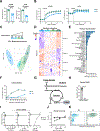Single-cell NAD(H) levels predict clonal lymphocyte expansion dynamics
- PMID: 38489349
- PMCID: PMC11064129
- DOI: 10.1126/sciimmunol.adj7238
Single-cell NAD(H) levels predict clonal lymphocyte expansion dynamics
Abstract
Adaptive immunity requires the expansion of high-affinity lymphocytes from a heterogeneous pool. Whereas current models explain this through signal transduction, we hypothesized that antigen affinity tunes discrete metabolic pathways to license clonal lymphocyte dynamics. Here, we identify nicotinamide adenine dinucleotide (NAD) biosynthesis as a biochemical hub for the T cell receptor affinity-dependent metabolome. Through this central anabolic role, we found that NAD biosynthesis governs a quiescence exit checkpoint, thereby pacing proliferation. Normalizing cellular NAD(H) likewise normalizes proliferation across affinities, and enhancing NAD biosynthesis permits the expansion of lower affinity clones. Furthermore, single-cell differences in NAD(H) could predict division potential for both T and B cells, before the first division, unmixing proliferative heterogeneity. We believe that this supports a broader paradigm in which complex signaling networks converge on metabolic pathways to control single-cell behavior.
Conflict of interest statement
Figures




References
-
- Chapman NM, Boothby MR, Chi H, Metabolic coordination of T cell quiescence and activation. Nature Reviews Immunology 2019 20:1 20, 55–70 (2019). - PubMed
-
- Heinzel S, Marchingo JM, Horton MB, Hodgkin PD, The regulation of lymphocyte activation and proliferation. Current Opinion in Immunology 51, 32–38 (2018). - PubMed
Publication types
MeSH terms
Substances
Grants and funding
LinkOut - more resources
Full Text Sources
Other Literature Sources
Molecular Biology Databases

